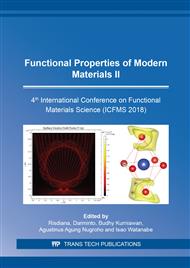[1]
Geim A. K., Novoselov K. S., The rise of graphene, Nat. Mater. 6(3) (2007) 183-191.
Google Scholar
[2]
F.A. Jumeri, H.N. Lim, Z. Zainal, N.M. Huang, A. Pandikumar, S.P. Lim, Dual functional reduced graphene oxide as photoanode and counter electrode in dye-sensitized solar cells and its exceptional efficiency enhancement, Journal of Power Sources, 293 (2015) 712-720.
DOI: 10.1016/j.jpowsour.2015.05.102
Google Scholar
[3]
K. S. Kim, Y. Zhao, H. Jang, S. Y. Lee, J. M. Kim, K. S. Kim, J. H. Ahn, P. Kim, J. Y. Choi, B. H. Hong, Large-scale pattern growth of graphene films for stretchable transparent electrodes, Nature 457 (2009) 706.
DOI: 10.1038/nature07719
Google Scholar
[4]
P. W. Sutter, J. I. Flege, E. A. Sutter, Epitaxial graphene on ruthenium, Nature Materials 7, 2008, 406.
DOI: 10.1038/nmat2166
Google Scholar
[5]
S. Stankovich, D. A. Dikin, R. D. Piner, K. A. Kohlhaas, A. Kleinhammes, Y. Jia, Y. Wu, S. T. Nguyen, R. S. Ruoff, Synthesis of graphene-based nanosheets via chemical reduction of exfoliated graphite oxide, Carbon 45 (2007) 1558.
DOI: 10.1016/j.carbon.2007.02.034
Google Scholar
[6]
Pei S, Cheng H-M, The reduction of graphene oxide, Carbon. 50 (2011) 3210-3228.
Google Scholar
[7]
Novoselov K. S., Geim A. K., Morozov S. V., D. Jiang, Y. Zhang, S. V. Dubonos, I V Grigorieva, A. A. Firsov, Electric field effect in atomically thin carbon films, Science 306 (2004) 666.
DOI: 10.1126/science.1102896
Google Scholar
[8]
Balandin A. A., Ghosh S., Bao W. Z., Calizo I., Teweldebrhan D., Miao F, Lau C. N., Superior thermal conductivity of single-layer graphene, Nano Lett. 8(3) (2008) 902-907.
DOI: 10.1021/nl0731872
Google Scholar
[9]
Bolotin K. I., Sikes K J., Jiang Z., Klima M., Fudenberg G., Hone J., Kim P., Stormer H. L., Ultrahigh electron mobility in suspended graphene, Solid State Commun. 146(9-10), (2008) 351-355.
DOI: 10.1016/j.ssc.2008.02.024
Google Scholar
[10]
Morozov S. V., Novoselov K. S., Katsnelson M. I., Schedin F., Elias D. C., Jaszczak J. A., Geim A. K., Giant Intrinsic Carrier Mobilities in Graphene and Its Bilayer, Phys. Rev. Lett. 100 (1) (2008) 016602.
DOI: 10.1103/physrevlett.100.016602
Google Scholar
[11]
O'Regan & Michael Gratzel, A low-cost, high-efficiency solar cell based on dye-sensitized colloidal TiO2 films, Nature 353 (1991) 737-739.
DOI: 10.1038/353737a0
Google Scholar
[12]
H. S. Jang, J. M. Yun, D. Y. Kim, D. W. Park., S. I. Na, and S. S. Kim, Moderately reduced graphene oxide as transparent counter electrodes for dye-sensitized solar cells, Electrochim. Acta. 81, (2012) 301–307.
DOI: 10.1016/j.electacta.2014.03.001
Google Scholar
[13]
Nair A. S., Peining Z., Babu V. J., Shengyuan Y., Ramakrishna S., Anisotropic TiO2 nanomaterials in dye-sensitized solar cells, Phys. Chem. Chemical Physics. 13 (2011) 21248–21261.
DOI: 10.1039/c1cp23085a
Google Scholar
[14]
J. Song, Z. Yin, Z. Yang, P. Amaladass, S. Wu, J. Ye, Y. Zhao, W-Q Deng, H. Zhang, and X-W Liu, Enhancement of photogenerated electron transport in dye-sensitized solar cells with introduction of a reduced graphene oxide-TiO2 junction, Chem. Eur. J. 17 (2011) 10832 – 10837.
DOI: 10.1002/chem.201101263
Google Scholar
[15]
L. Wei, P. Wang, Yulin Yang, Z. Zhan, Y. Dong, W. Song and R. Fan, Enhanced performance of the dye sensitized solar cell by the introduction of graphene oxide into the TiO2 photoanode, Inorg. Chem. Front. 5 (2018) 54.
DOI: 10.1039/c7qi00503b
Google Scholar
[16]
S. P. Lim, A. Pandikumar, N. M. Huang, and H. N. Lim, Reduce graphene oxide-titania nanocomposite-modified photoanode for efficient dye-sensitized soalr cell, Int. J. Energy Res. 39 (2015) 812–824.
DOI: 10.1002/er.3307
Google Scholar
[17]
V. Marcelina, H. Addini, N. Syakir, A. Bahtiar, S. Wyantuti, Y. W. Hartati and Fitrilawati, Preparation of graphene oxide thin films using cyclic voltage electrochemical deposition method and its characterization, J. Phys.: Conf. Ser. 1080 (2018) 012028.
DOI: 10.1088/1742-6596/1080/1/012028
Google Scholar
[18]
S. Sarker, H. W. Seo, K. S. Lee, Y. K. Jin, H. Ju, and D. M. Kim, Exact analytical analysis of current-density voltage curves of dye-sensitized solar cells, Sol. Energy, 115 (2015) 390–395.
DOI: 10.1016/j.solener.2015.03.009
Google Scholar
[19]
L. Safriani, A. Nurrida, C. Mulayana, T. Susilawati, A. Bahtiar, A. Aprilia, Calculation of DSSC parameters based on ZnO/TiO2 mesoporous photoanode, IOP Conf. Series: Earth and Environmental Science 75 (2017) 012004.
DOI: 10.1088/1755-1315/75/1/012004
Google Scholar
[20]
A. Aprilia, L. Safriani, Wa Ode S. Arsyad, N. Syakir, T. Susilawati, C. Mulyana, Fitrilawati, R. Hidayat, ZnO/TiO2 bilayer heterojunction as a working electrode in quasi solid dye sensitized solar cells, IOP Conf. Series: Materials Science and Engineering 214 (2017) 012033.
DOI: 10.1088/1757-899x/214/1/012033
Google Scholar
[21]
G.M.M.W. Bissels, J.J. Schermer, M.A.H. Asselbergs, E.J. Haverkamp, P. Mulder, G.J. Bauhuis, E. Vlieg, Theoretical review of series determination methods for solar cells, Solar Energy Materials & Solar Cells, 130 (2014) 605–614.
DOI: 10.1016/j.solmat.2014.08.003
Google Scholar


